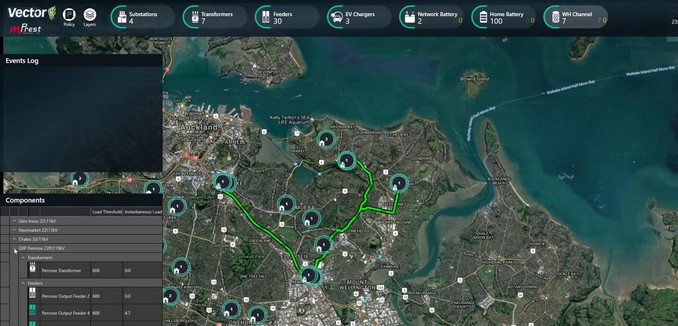Typhoons, floods, droughts, earthquakes, hurricanes, wildfires — the frequency and intensity of natural disasters across the globe are worsening, and these deadly events could continue plaguing the planet as a result of climate change.
Hoping to minimize disruption of essential services in disaster zones, government and utility officials are seeking better solutions for preparation and management of catastrophic weather events.
One new solution is a sophisticated product from mPrest Systems, the private Israeli company that famously developed the command-and-control software inside Israel’s Iron Dome missile-defense system.
Natan Barak, founder and CEO of mPrest, explains that the Major Event Management Application (MEMA) automatically forecasts the extent, location and progress of damage via a network of sensors and systems that jointly gather and analyze current weather and other relevant data using advanced algorithms.
“It is based on the same ‘system of systems’ architecture we developed for the Iron Dome,” he tells ISRAEL21c. “We are now applying rocket science, which was originally designed to save lives, to improve quality of life.”
How does that work?
“The Iron Dome is, in essence, a real-time distributed asset analytics and management system,” he explains. “The system accumulates data from tens of thousands of sensors to detect when a missile is launched, calculate its path, and decide if, when and where to intercept so that citizens and communities remain safe.”
That same technology can be integrated into, say, smart-grids and cloud-based irrigation systems. And in the case of MEMA, it helps utilities handle disasters.
Earthquake scenario
Let’s imagine, for example, that an earthquake is anticipated in a city like San Francisco.
First of all, MEMA would enable local utilities to develop simulation tools for a disaster plan by leveraging historical data from previous disasters.
Then, based on data from hundreds of thousands of sensors, the application would pinpoint high-risk areas where resources should concentrate in order to mitigate potential damage.
Once the quake hits, MEMA would automatically notify the utility, in real time, of incidents and continuously gather data from its sensors and systems — including satellite and drone imagery – to provide information on rising temperatures, rising wind levels, unusual ground motion, and more.
Barak says the application’s sensors can also do a “health check” of critical assets such as power lines and electrical transformers so that utility and other officials can make informed real-time decisions.
“Based on the earthquake’s epicenter, ground movement and more, the application can help identify power and utility infrastructure — lines, transformers, breakers, etc. — as well as critical facilities — schools, hospitals, etc. — that are in the event’s path,” Barak tells ISRAEL21c.
With this information in hand, officials could assign restoration crews and materials based on location and damage assessment.
“The ‘system-of-systems’ application can then combine both real-time and filed data to create an optimal restoration plan that accelerates recovery times and reduces restoration costs,” explains Barak.
mPrest is in discussions with potential utility clients for MEMA, many in the United States.
Smart cities
Barak says this latest product is part of mPrest’s increasing focus on the distributed energy resource management system (DERMS) market.
Based in Petah Tikva, mPrest was founded in 2003 by command-and-control technology experts originally from the defense industry. Today the company has 240 employees and additional offices in the US, UK and Australia.
In partnership with system integrators and organizations, mPrest develops monitoring and control solutions that serve defense and security organizations, electric and water utilities, smart cities, fleet management companies, and other enterprises worldwide.
Two years ago, the New York Power Authority deployed mPrest’s Asset Health Management application at its Niagara Power Plant, one of the largest renewable energy sources in the US. The application enhances the reliability and cost effectiveness of its transformer system by accurately diagnosing and predicting potential failures.
In January, mPrest and Atlanta-based Southern Company energy company received a BIRD Energy grant to develop and implement a solution to enhance the resiliency, efficiency and flexibility of Southern Company’s distribution system in the face of “rapidly decentralizing networks, sharp changes in energy demand, extreme weather events and cyber security threats.”
Energy utilities are also one of the main clients for mPrest’s mCity platform, which helps municipalities optimize resource consumption, improve decision-making and planning, engage residents and improve overall quality of life and services.
Flexible implementation options for mCity are designed to cut the typically expensive and lengthy time it takes to get smart-city infrastructure installed; it can start out small and grow as needed.
Barak says mCity offers several unique features that set it apart from monitoring, control and analytics products and platforms offered by major multinationals such as GE and Siemens: for instance, the ability to integrate quickly with a client city’s existing and future third-party platforms and sensors of any brand; and the ability to include smart energy in the package.
“We offer everything under a single platform,” says Barak. “None of our competitors offers all these capabilities in one overarching ‘system of systems.’”
Just as the market for mPrest’s Major Event Management Application may expand due to natural disasters influenced by climate change, Barak predicts that mCity will be in greater demand as cities seek ways to provide efficient and reliable digital infrastructure serving the increasing population shift to urban areas.
(via Israel21c)
[Photo: Israel21c ]




